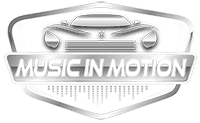As a motorcycle enthusiast, you know there’s nothing quite like the feeling of cruising down the open road with the wind in your hair and your favorite tunes blasting in your ears. However, finding the right audio system for your ride can be a daunting task. With so many options available, it’s hard to know where to start. That’s why we’ve put together this definitive guide to motorcycle audio, to help you choose and install the best audio system for your needs.
It can be difficult to choose the best radio, amplifier, and speaker improvements for your motorcycle audio system. This buying guide has been created by Music In Motion’s team of mobile enhancement professionals to assist you in selecting the best solutions to make your wind treatment more fun. Whether you’re upgrading the audio system on a Harley-Davidson or BMW touring bike or just want to add a sound system to something more basic, we want to make sure it sounds amazing!
Elite Restomods is the nation’s premier classic car dealer, and they use Music In Motion for all their car audio designs and installs. In fact, we also install audio systems on all of their classic motorcycles.
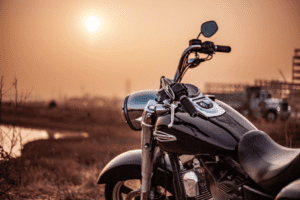
There are several reasons to replace the radio on an older motorcycle: to add Bluetooth audio streaming, support for digital media file playback, or add preamp outputs to improve the performance of an amplifier. Radios come in a variety of shapes and sizes, depending on the type of bike. You have the option of installing an aftermarket radio or not. As a result, where there is a will, there is a way.
Rockford Fosgate and Aquatic AV offer customized radios that will drop directly into the fairing and plug into the factory wiring for owners of Harley-Davidson touring bikes from 1998 to 2013. The radio control buttons on the handlebars are compatible with both radios.
If you can ensure the bike will never see rain, another alternative for these bikes is to use one of the floating-face radios from Kenwood, Sony, or Alpine. A single-DIN chassis with an enlarged screen mounts in front of the fairing on these radios. The end result resembles the radio designs found in new Audi and Mercedes-Benz automobiles. The screens on these radios are substantially larger, ranging from 8.95 inches to a huge 11 inches for the new Alpine ILX-F411. Adjustments are easy to make while riding with larger screens. Naturally, you’ll want to check with your store to make sure the radio won’t interfere with any gauges or switches.
These models must be kept dry unless they clearly declare that they are weather-resistant. The face and electronics cannot get moist, even if the circuit boards have a corrosion-resistant coating. This sort of radio has the advantage of having a reverse-LCD display, which is easier to view in bright sunshine than their standard car audio counterparts.
The Saddle Tramp 95-HDIF improvement, which replaces the inner fairing on this generation of Harley cruisers, is another popular addition. It includes a double-DIN source unit to allow adding technologies like Apple CarPlay and Android Auto easier. Because Sony has added water-resistant characteristics on the front panel, the Sony XAV-AX7000 multimedia receiver is an excellent choice for this application.
Using a steering wheel control interface, your shop can usually connect your new radio to the control buttons on the handlebars. Axxess, Scosche, PAC, and iDatalink are just a few of the companies that provide solutions.
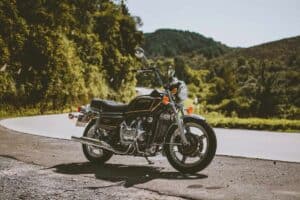
Harley-Davidsons, Yamaha Ventures, Honda Goldwings, BMW K1600s, Indian Roadmasters, and Kawasaki Voyagers are all excellent bases for audio system modifications. You won’t be able to simply change the radio on most of these bikes, so your best bet is to make do with what you have.
Connecting a high-power amplifier and modern speakers to these radios with a digital signal processor like the ARC Audio PSM is ideal. These processors allow your installer to maximize the performance of new speakers and change radio speaker-level signals to work with an amplifier. These DSP systems can manage radio equalization, so your music sounds great.
Some systems, such as the PSM, allow you to set different settings for different situations, such as hanging out with friends, cruising about town, or riding down the Interstate. To power the speakers, you’ll need to add an amplifier after these processors.
Flashing Harley-Davidson Radio
If you have a 2014 or newer Harley with the Boom! Box radio, it’s likely that the radio has been set up with an equalization curve that maximizes the performance of the factory speakers. It’s a recipe for disaster to upgrade to new amplifiers and speakers without first modifying the EQ curve.
TechnoResearch offers a radio reprogramming service that allows your dealer to set the radio’s response curve to a more relaxed state. While not completely flat, radio flashing will improve the sound quality and longevity of your audio system. To ensure a truly smooth frequency response and a realistic listening experience based on the speakers you’ve chosen, we recommend using a DSP.
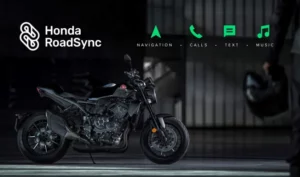
The Definitive Guide to Motorcycle Audio is especially helpful if you’re upgrading a motorcycle that doesn’t have a radio, a Bluetooth audio streaming solution can be a good option. There are two types of Bluetooth receivers available. The first is a hidden module that allows you to listen to music from your phone or via a streaming audio provider such as Pandora, Spotify, or iHeartRadio.
The phone serves as the system’s source unit, and you’ll regulate the volume of your audio system using the phone’s volume control keys.
A Bluetooth receiver with volume, music selection, and play/pause controls. AVRCP has been introduced to A2DP, which streams audio to these receivers. The receiver’s buttons control your phone’s music and volume. You can control your phone while it’s in the source unit from the receiver. These Bluetooth receivers’ preamp outputs power external amplifiers and speakers.
To hear your music well while going at 65 miles per hour, you’ll need loudspeakers and an amplifier capable of driving those speakers without distortion. Motorcycle amplifiers come in two- and four-channel variants with power ratings ranging from 45 to over 150 watts per channel.
You’ll need an efficient amplifier that fits on your bike. Motorcycles don’t have the same reserve current supply as cars or trucks. 20 to 25 amps are typical. You’ll need an amplifier that can drive your speakers with minimal current. Most motorcycle amplifiers are above 90% efficient.
Consider where the shop will install your motorcycle’s amp. If it’s in a saddlebag, it’s protected from precipitation, dust, and debris, but it may not have enough airflow to stay cool. Most amplifiers are mounted on the front fairing. This shelter is not watertight. Rockford Fosgate and JL Audio make waterproof amplifiers with IPX6 or IPX7 ratings.
One of the most important aspects of replicating your music with precision and detail is the speakers you choose for your audio system. Consider how horrible your music would sound if you had a wonderful source unit and a high-power amplifier coupled with cheap auto parts store speakers. Yuck!
Three essential requirements must be met by motorcycle speakers: They must be able to tolerate long periods of UV exposure. They must be able to play loudly and with a lot of power. Last but not least, they must be water-resistant. Naturally, every speaker should have a smooth frequency response that is devoid of peaks, dips, or undesirable resonances that detract from the listening experience. It’s not easy to combine all of these characteristics into a single product.
Speaker Size and Type: The size and type of speakers you choose will depend on your motorcycle and personal preferences. Round and oval-shaped speakers are the most common, but you can also choose custom-shaped speakers to fit your motorcycle’s unique design.
Sound Quality and Frequency Response: Look for speakers with a high sound quality and a wide frequency range. This will ensure that you get a clear and crisp sound from your audio system.
Weather Resistance and Durability: As motorcycles are exposed to the elements, it’s important to choose speakers that are waterproof, shock-resistant, and built to withstand the vibrations of the road.
Brand and Price: Consider the brand reputation and price when choosing speakers for your motorcycle. Popular brands like Harley-Davidson, Boss Audio, and Kicker offer a range of speakers at different price points, so you can find the right speakers for your budget.
By taking these factors into account, you can choose speakers that will provide the best sound quality and durability for your motorcycle audio system. Be sure to also consider the compatibility of the speakers with your motorcycle and audio system to ensure a seamless installation process.
The Joy of Riding with Music: Music can elevate your mood and make your ride more enjoyable. With a motorcycle audio system, you can listen to your favorite tunes and make the most of your time on the road.
Improved Safety and Communication: Some motorcycle audio systems come with built-in communication systems that allow you to communicate with your riding buddies without having to take your hands off the handlebars. This can help you stay connected and improve safety on group rides.
Increased Resale Value: Installing a quality audio system on your motorcycle can increase its resale value. This is especially true if you choose a popular brand and have the system professionally installed.
Customization Options: Motorcycle audio systems come in a variety of shapes, sizes, and styles, allowing you to choose the system that best fits your motorcycle and personal preferences. You can also choose to add additional features like Bluetooth connectivity, LED lighting, and more.
Entertainment on Long Rides: Long rides can be tiring and boring, but with a motorcycle audio system, you can keep yourself entertained and energized. You can listen to music, audiobooks, or even podcasts to make the most of your time on the road.
Overall, motorcycle audio systems offer a range of benefits that can enhance your riding experience and make your time on the road more enjoyable and safer.
When you go to your local specialty mobile improvement merchant to look for new speakers, you should have a list of questions prepared to go along with a listening audition. When it comes to UV protection, you want something that won’t fade, chalk, yellow, or crack after being exposed to the sun for a year or two. Waterproofing’s included in the speaker’s design. Because UV stabilizers, applied during the manufacturing process, polypropylene cones are the easiest to make UV resistant. Cones made of paper, composite, or carbon fiber often do not fare as well.
A flexible secondary seal around a centrally positioned tweeter mounting post is critical in coaxial setups. A tweeter affixed to a bridge that spans the woofer’s used in many recent motorcycle-specific speakers. This design allows for a larger woofer with more surface area, which improves efficiency and midbass output.
It’s not the same as auditioning a set of speakers made for a motorcycle as it is for a conventional automobile audio application. To begin, you’ll notice that in order to improve their efficiency, these speakers lose some bass and midbass output. Higher frequencies, emphasized on the top end, help overcome wind noise or allow you to hear music through a helmet.
When placed on your bike, what appears bright or aggressive on a display may sound fine. Having stated that, during the auditioning process, the standard criteria of smooth response and lack of resonance remain true. No amount of tuning will be able to remove distortion if the midrange is harsh or the speakers sound muddy.
In the front fairing of most touring bikes are 4-, 5.25-, or 6.5-inch speakers. You can choose like-sized replacements if you’re having things upgraded. There may be adapters available that will allow your installer to install a larger speaker in the same spot without having to adjust or modify the motorcycle. The most typical location for rear speakers on motorcycles is on either side of the back seat. Known as Tour-Pak speakers, on Harley-Davidson motorcycles. These speakers are usually a little smaller, measuring about 5.25 inches in diameter.
If you want greater output, you may install additional speakers after you’ve picked outstanding speakers for the existing positions on your bike. Several firms produce pods designed to attach speakers on each side of the radiator or the engine guard for Harley-Davidson owners. The majority of these speakers made of 6.5-inch speakers. “Lowers” refers to the location of the speakers.
Upgrading the lids on a set of saddlebags for the back of your bike is a terrific way to add big sound to your motorcycle audio system. Although most of these lids have room for a 6-9 speaker, others employ 6.5-inch or dual 6.5-inch or 8-inch drivers. These lid covers come in a variety of colors or can be custom painted to fit your bike.
The Rockford Fosgate TMS69BL9813 and TMS69BL14 kits are a great upgrading choice for bag lid speakers. These kits contain a template for adding grilles to your current bag lids by your installer. The main advantage is that your lids aren’t painted, allowing you to finish the speaker update in a matter of hours rather than days.
Of course, if your motorcycle isn’t as well-supported as Harleys, there are still plenty of upgrade possibilities. To accommodate new speakers, the shop can construct unique mounting solutions or adapt a saddlebag, storage trunk, or fairing.
For motorcycles without fairings, compact stand-alone speaker systems are also available. To provide an all-in-one sound system, these speaker solutions often feature a built-in amplifier and a Bluetooth receiver. Keep in mind that, while these solutions are amazing, they won’t match the output of a pair of 6.5-inch drivers in a fairing driven by a high-quality amplifier.
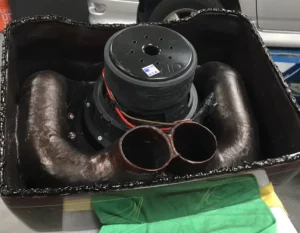
The Definitive Guide to Motorcycle Audio makes clear it’s quite tough to replicate the lowest notes of your song on a motorcycle. You don’t have the benefit of a compact cabin pressed by a relatively modest speaker like you would in a vehicle. Consider the number of speakers and the wattage required to produce bass for an open-air rock concert.
You’ll also have to contend with the motorcycle’s own exhaust noise. If you believe that “loud pipes save lives,” the task will be significantly tougher for you. Last but not least, subwoofers require suitable enclosures to perform properly. Of course, saddlebags, Tour-Paks, and trunks are available.
Adding a subwoofer that focuses on 50 to 125 Hz could reduce the effort the small speakers have to do. You’ll need a subwoofer that can handle midbass. Don’t expect to hear synthesizer or organ lows on the road.
As important as the parts you choose are, how they’re installed affects performance and reliability. ARC Audio and Rockford Fosgate sell installation tools and connectors that work with Harley-factory Davidson’s wiring, but learning how to disassemble your bike, run wires following the factory wire channels, and design a new amplifier requires instruction. You should see confirmation that the shop has worked on similar motorcycles and, if possible, audition their systems before letting them work on yours.
If you’re upgrading a newer bike that may still be covered by the manufacturer’s warranty, make sure the shop installing your speakers and amplifier is aware that no wire should be removed.
You’ll want a store with good after-sales service, as with any other electronics or entertainment purchase. If you have questions or want to expand the system, they can help. They can service any part. During a concert or rally, avoid “on-street” renovations. How will they stand by what they sold you if they’re far away?
Can You Listen to Music While Riding a Motorcycle?
A. Yes, you can listen to music while riding a motorcycle. Many modern audio systems come with Bluetooth connectivity, allowing you to wirelessly connect your phone or other devices. You can also connect using an aux cord or USB cable.
What Is the Loudest Motorcycle Audio System?
A. The loudest motorcycle audio system will depend on the speaker size, wattage, and amplification. Some popular brands known for producing high-quality, loud audio systems include Kicker and Rockford Fosgate.
How Do I Connect My Phone to My Motorcycle Audio System?
A. Most motorcycle audio systems come with Bluetooth connectivity, allowing you to connect your phone wirelessly. You can also connect using an aux cord or USB cable, depending on your audio system.
Can I Install a Motorcycle Audio System on My Own?
A. Yes, you can install a motorcycle audio system on your own if you have the right tools and knowledge. However, if you’re not confident in your skills, it’s recommended to hire a professional to avoid damaging your motorcycle or audio system.
Are Motorcycle Audio Systems Legal?
A. Yes, motorcycle audio systems are legal as long as they don’t exceed certain volume limits. Different states and countries may have different laws regarding the use of audio systems while riding, so be sure to check your local laws and regulations. Additionally, it’s important to use common sense and avoid playing music at excessively loud volumes that can be a distraction to yourself and others on the road.
Remember to consider factors like speaker size, sound quality, durability, brand reputation, and price when choosing speakers for your motorcycle. Amplifiers can also be a valuable addition to your audio system, improving sound quality and power. However, whether or not you choose to use an amplifier will depend on your personal preferences and the quality of your speakers.
When it comes to installation, take your time, use the right tools, and consider seeking professional help if needed. By following these tips and tricks, you can ensure a successful and safe installation of your motorcycle audio system.
Overall, a motorcycle audio system can provide entertainment, safety, and customization options for your rides. So, turn up the tunes, hit the open road, and enjoy the ride with your new audio system. Ready to take your ride to the next level? Contact Music In Motion for all your motorcycle audio needs! From speakers and amplifiers to installation services, Music In Motion has everything you need to enhance your riding experience.
